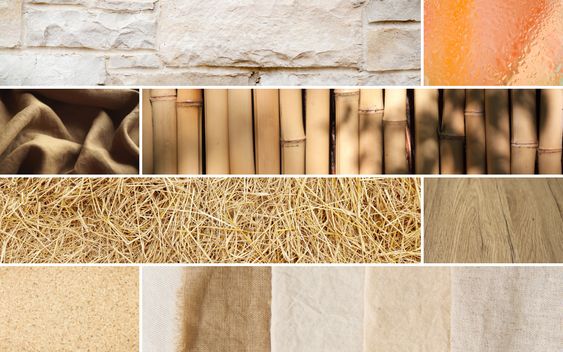In an era where sustainability and eco-consciousness have taken center stage, the materials we select to construct and adorn our homes play a crucial role.
When we understand the importance of incorporating nature into our spaces, the use of natural materials is pivotal.
For example, doesn’t it make you feel better when you enter an environment with natural wood? or when you HYGGE up under a soft wool blanket?
What about recycled materials?
After all, we know that the number one rule for sustainability is to consume less and protect the natural environment from over-exploitation.
Even without going into the details of the single materials, we know that both of these options have their benefits and drawbacks: so let’s take a closer look and work our way to understanding why a balanced approach is not only environmentally responsible but also aesthetically pleasing.
1 Benefits and Drawbacks of Natural Materials
Natural materials have been the foundation of home construction and interior design for centuries. These materials are derived directly from the earth and can add a unique touch to any living space. Over time, some of these natural materials have been replaced with plastic or other chemically treated forms, which can create toxic environments – not ideal.

1.1 Benefits of Natural Materials:
-
- **Aesthetic Appeal:** Natural materials such as wood, stone, and clay offer an inherent warmth and beauty that is hard to replicate with other materials. They engage multiple senses and create a cozy and inviting atmosphere in a home. Their indirect link to the outside world taps into our ancestral need to be closed to nature and feel at ease.
-
- **Durability:** Many natural materials are known for their long-lasting properties. For example, hardwood floors can withstand years of wear and tear, and natural stone countertops are both elegant and resilient. The signs of wear and tear can even enhance their connection to place.
-
- **Biodegradability:** Unlike synthetic materials, natural materials do not release harmful chemicals into the environment when they break down. They can be disposed of without causing long-term harm to the planet, provided they are truly natural without extra chemical finishes.
1.2 Drawbacks of Natural Materials:
-
- **Environmental Impact:** The extraction of natural materials can harm ecosystems due to overexploitation, leading to deforestation, habitat destruction, and soil erosion. Unless sourced responsibly following guidelines, regulations, and possibly certifications, it may take decades or even centuries to replace the resources used.
-
- **Maintenance:** Natural materials often require more maintenance than their synthetic counterparts. For example, wood may need regular staining or oiling to maintain its appearance and structural integrity.
What we do to our resources not only afffects our home environment but also our environment at large. As professionals of theh home industry we are accountable for approx 40% of carbon emissions.
Our decisions matter.
If you have not had a chance to see the documentary , Before the flood by Mr Leonardo Di Caprio and national Geografic, although a few years old, I strongly suggest you do.
2. Benefits and Drawbacks of Recycled Materials
Recycled materials, on the other hand, are products made from reusing or repurposing materials that would otherwise end up in landfills. They offer unique advantages but also come with their own set of challenges.
Did you know that we produce 8.3 billion metric tons of plastic, of which 6.3 become plastic waste, and only 9% is actually recycled. Where do you think the rest goes?
While some may argue that it is best to use natural materials over plastic, even recycled and, mark my word, I am a convinced advocate for natural materials and health benefits they provide; I am also an advocate for cleaning up our environment and finding ways to repurpose and reuse materials, furnishings and other objects.
As Humans, having done damage to our planet by polluting with excessive plastic, to compensate we now need to reach a tipping point where we use much more recycled plastic materials than new materials.
Yes this may take some time.
As long as we continue to produce virgin plastic, we will be chasing an unachievable goal of cleaning our oceans. So, remember to always ask for recycled plastic and recycled materials in general because the number one rule of sustainability is to consume less and extend the lifecycle of our products. We create demand and industry will follow.

2.1 Benefits of Recycled Materials:
-
- **Reduced Waste:** Using recycled materials diverts waste from landfills, decreasing the environmental impact associated with disposal.
-
- **Resource Conservation:** Repurposing existing materials reduces the demand for virgin resources, such as timber and minerals, helping preserve natural habitats.
-
- **Innovation:** Recycled materials can encourage innovation in design and construction, often coming with a unique story, adding character and history to the space that can create an original USP
-
- **Sence of place:** Repurposing old furniture or some that we have inherited not only gives new functionality to the object but also strengthens the sense of place as it taps into our emotions and memories.
2.2 Drawbacks of Recycled Materials:
Yes, we have drawbacks, which is why we cannot completely halt production. Some industries require very high quality and resistance that cannot be guaranteed by recycled products.
-
- **Quality Variability:** The quality of recycled materials can vary, potentially resulting in inconsistencies in the final product, which may lead to structural or aesthetic issues in some cases.
-
- **Limited Availability:** Not all building or decorative materials can be easily recycled, making it challenging to use recycled materials exclusively for certain projects. Did you know that in the oceans, the majority of microplastics come from paint?

3. Why a Mix of Both is Ideal
While both natural and recycled materials have their unique advantages and setbacks, the most sustainable and aesthetically appealing approach is to combine them. Here are some reasons why:
-
- **Sustainability:** A balanced approach allows us to benefit from the beauty and durability of natural materials while reducing the environmental impact of over exploitation by incorporating also recycled materials.
-
- **Versatility:** Combining these materials provides greater design flexibility, allowing homeowners to achieve a diverse range of looks and styles. connect our heritage or childhood memories that help create a sense of belonging
-
- **Economic Considerations:** Mixing natural and recycled materials can be cost-effective, as recycled materials are often more budget-friendly.
-
- **Resilience:** Natural materials can provide structural integrity, while recycled materials can enhance the uniqueness of the design. Together, they create a more resilient and dynamic living space.
-
- **Environmental Responsibility:** Balancing the use of both types of materials helps us strike a chord with the environment. We are reducing the demand for virgin resources while minimizing the environmental impact of extraction and disposal.
4. My Conclusion
Creating eco-friendly spaces in our homes is not just a trend but a responsibility in today’s world. Both natural and recycled materials offer distinct advantages and setbacks. However, the ideal approach is to find a balance that combines the best of both worlds. By using a mix of natural and recycled materials, we can achieve the aesthetic and structural qualities of natural materials while reaping the benefits of sustainability and waste reduction that recycled materials offer. This approach not only makes our homes more beautiful but also helps protect the planet for future generations. In a world that demands eco-consciousness, using a blend of natural and recycled materials is the way forward for responsible and attractive home design
